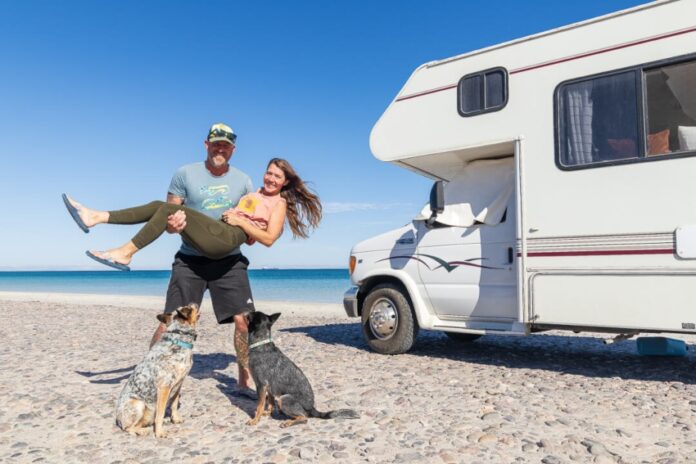When it comes to RVing in Baja, an adventure enjoyed by thousands annually, Chris and Lindsay Harvey are acknowledged experts. Not only did they, as Chris likes to say, literally write the book on the subject — “RVing and Camping the Baja Peninsula” — they’ve also founded the website RVing Baja. The Harveys also recently took over as operators of Baja Amigos, which, since its founding in 2009 by Dan and Lisa Goy, has been the foremost specialist in small-size RV caravan tours through Baja.
That expertise is on full display speaking with Chris, as he discusses all aspects of RVing in Baja, from boondocking and border crossing tips to preparing your RV to weather the climate and road conditions of a long journey through one of the most ruggedly beautiful places on Earth.
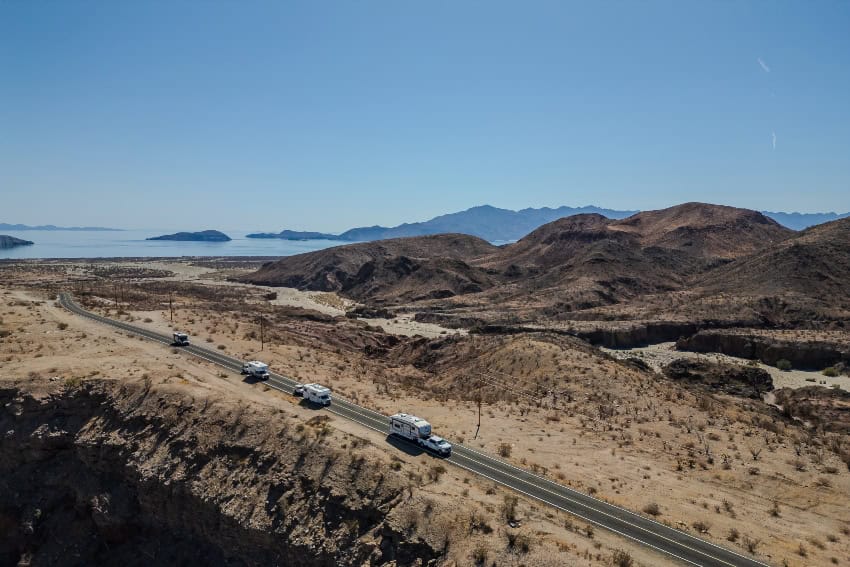
Mexico News Daily: What are the must-know border crossing tips for RVers in Baja?
Chris Harvey: Certain paperwork is required for any RVers crossing into Baja. This includes the Forma Migratoria Múltiple (FMM), Mexican auto insurance and vehicle registration — including towed trailers or vehicles — valid for up to 180 days, which is the maximum length of time travelers are permitted to visit Baja.
To obtain the FMM, travelers must present a passport and pay the fee of approximately US $45. It is the traveler’s responsibility to request the opportunity to pull over at the border to process the FMM. There is a misconception, particularly at busier border crossings, that if the border agent does not tell you to get an FMM, then you do not need one. You absolutely need one. That is, if you plan to spend more than 72 hours beyond the 20-mile free border zone.
Is there anything new in 2025?
Effective in 2025, there are reports of special immigration officers checking tourists for their FMMs. If you travel without an FMM or the mandatory liability insurance on your vehicle, then you are breaking the law. Yes, the consequences can be severe. Also, if traveling with a pet, you must have up-to-date rabies vaccinations good for the duration of your travels, up to 180 days. The CDC now requires an additional fee-free form to be completed upon returning to the U.S.
When you choose to travel with Baja Amigos, we assist in processing all paperwork to ensure that each of our guests is a legal visitor in Mexico, properly insured and comfortable knowing that we are with them as we all cross the border together.
Which attractions in Baja California are best suited for RV travelers?
There are lots of great activities that attract RV travelers to Baja each year, particularly between late fall and early spring. From vineyards and wine tasting in Valle de Guadalupe in Baja California to gray whale watching along the Pacific Coast of Baja California Sur, campers can expect loads of unique experiences.
By far, the biggest attractions in the busy RV season are the whale watching opportunities. Whether gray whale “petting” in the northern part of Baja California Sur or watching humpbacks breach and play in the waters near Cabo San Lucas along the East Cape, whales are a definite theme for attracting campers during the winter months. Additionally, travelers have the unique opportunity to swim with whale sharks in La Paz during this time, adding to the wildlife theme that offers all sorts of attractions during the winter.
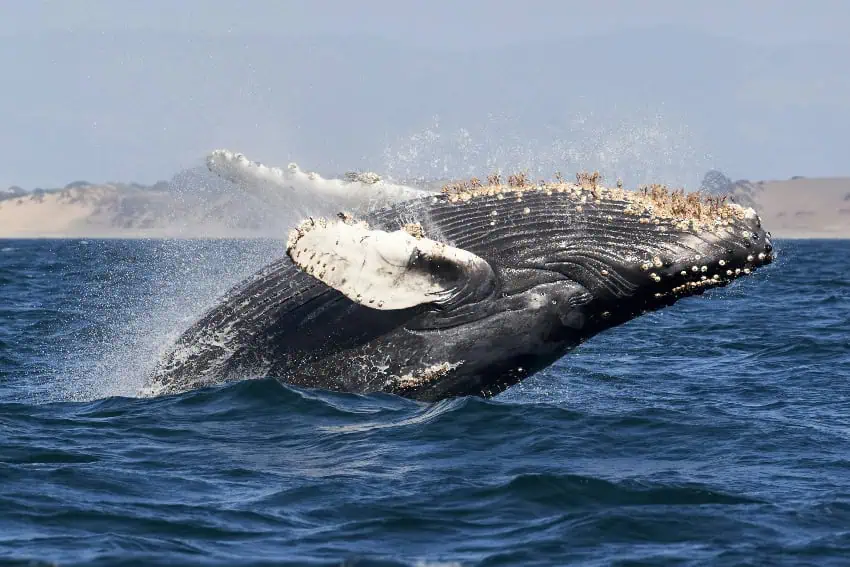
Which places do people most want to visit?
Many campers are generally attracted to warmer weather and water, where they can explore and stay on a variety of beaches on either side of the peninsula. Most prefer the warmer winter waters of the Sea of Cortés [Gulf of California] in places like Bahía de San Luis Gonzaga, Bahía de Los Ángeles, Bahía de Concepción and the beaches that stretch between La Paz and Cabo San Lucas along the East Cape.
Others prefer the Pacific side of the peninsula, which offers surfing, fishing, and whale watching, and great artistic communities such as San Juanico (Scorpion Bay), and Todos Santos and Los Cerritos.
Beachside camping is one of the unique features of Baja, where campers can either camp for free or for a minimal fee and wake up with million-dollar views outside their door. Then there are treasures to be found in the desert, including the otherworldly landscapes of Cataviña and oasis towns such as San Ignacio and Mulegé, each boasting rich history and historical missions. Culturally speaking, Loreto is incredibly popular with campers and is an outdoor enthusiast’s playground. From fishing to water sports in the offshore national park to inland hikes and day trips to explore the San Javier mission and town, Loreto has something for everyone. And the food options in Loreto — incredible!
Which places are not for everyone?
Los Barriles, along the southern end of the peninsula, is also a camper’s haven with a handful of great campgrounds centrally located in a town that is arguably the most popular among expats in the southern state of Baja California Sur. Hyperscenic views on the drive in and around Los Barriles and a very English-friendly community make Los Barriles popular with campers who may want or need a little break from some of the smaller towns and villages that might have lacked the amenities they are used to when traveling in the U.S. and Canada.
We say that people either love or hate towns like Los Barriles and Loreto because they can be much more “comfortable” than other destinations throughout the peninsula. So, depending on whether you are seeking an authentic Mexican experience or want to spend some time where the living is easy, these destinations may be filled with the kind of attractions and relaxation that attract RV campers.
We have designed all of our Baja Amigos caravan itineraries to visit the most popular and must-visit destinations and include or offer optional tours for all of the activities and excursions that attract campers during the winter months. We mix beach camping with formal campgrounds and include highlights such as wine tastings, whale watching and historic town and mission tours in all of our caravans, giving our guests an action-packed overview tour of Baja, leaving them wanting for very little on their Baja-camping bucket list.
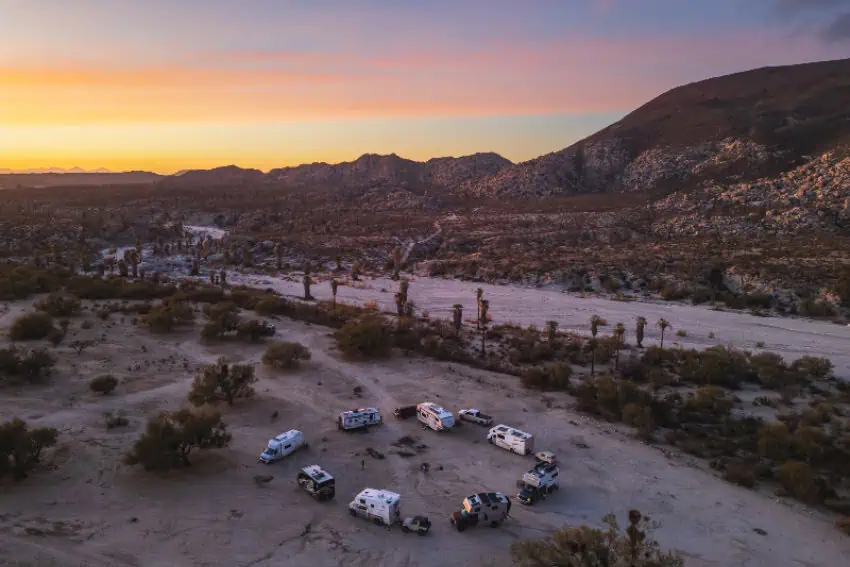
How can someone ensure their RV is prepared for Baja’s terrain and climate?
The peak of RV camping is between November and early April, when the temperatures are typically mild, particularly for those campers traveling from northern U.S. states or Canada. However, during this time, nights and mornings can be cool and in the 50-degree Fahrenheit range in Baja California, while daytime temperatures can be warm (over 80 degrees Fahrenheit) in Baja California Sur.
So campers must be prepared for a range of temperatures when preparing to visit Baja. Between April and October, temperatures are generally considered unbearably hot, so if one plans to RV through Baja during the summer, they would need to account for hot temperatures that are over 100 Fahrenheit in many places. Typically, the summer offers better surfing and fishing. But because the temperatures are so extreme, most RVers will not travel during this time.
In terms of terrain, there is one main highway (Federal Highway 1) that runs nearly 1,000 miles through the length of the peninsula and is the primary backbone of transportation for all vehicles, including semi-trucks. The roads tend to be narrow, often without a shoulder and in various states of repair or disrepair. The highway traverses a variety of desert landscapes with several steep grades, but mostly flat or gently rolling hills. Because Baja is a desert, there are long stretches between towns and villages where cellular service is not to be expected.
What are the best preventative steps before starting out?
Because of the road and terrain conditions, we recommend that every traveler invest heavily in preventative maintenance for their vehicle(s) before they cross into Baja. This is particularly important for many travelers with Mercedes or other custom vehicles that may require special parts or fluids. In this case, we advise carrying spares of vehicle-specific items. Many skilled mechanics in Baja will go out of their way to assist. But if a part is not available, it can be incredibly challenging and inconvenient for travelers to find ways to ship parts to where they are awaiting repair.
We also advise that RVers inspect and replace any tires that are on their last legs and carry at least one full-size spare. Tire-repair shops are numerous along the highways in Baja because tire repairs are such common issues, and tires can typically be patched or installed easily. But when it comes to travel trailer and fifth-wheel trailer tires, bring two spares if possible, as trailer tires are not common along the peninsula.
Our Baja Amigos wagonmasters are all incredibly helpful in assisting our guests who experience issues related to terrain or climate. While we do not mandate mechanical proficiency, they have all traveled extensively throughout the peninsula for years and have loads of resources and contacts to assist when needed. We also travel at safe speeds and in the smallest group sizes of any company operating caravans in Baja, so our guests can feel comfortable knowing that they will receive adequate assistance in the event of traveling incidents.
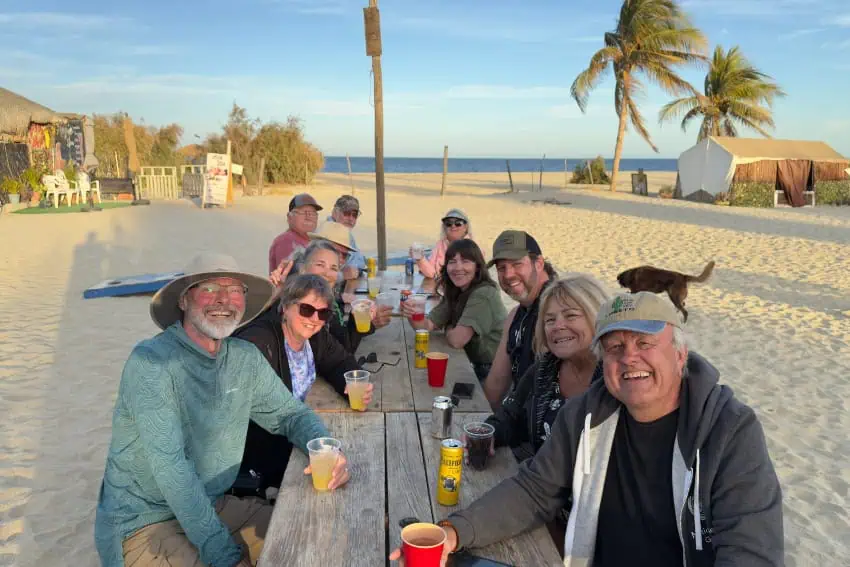
Is traveling alone safer or more enjoyable than with others in Baja?
Although we are in the business of leading small groups of campers through Baja, we are also the first to say that traveling in a caravan is not necessary for either safety or enjoyment. However, there is no doubt that traveling in a group is typically more fun, and there is always safety in numbers.
Baja is generally safe for campers, and the Mexican people are wonderfully hospitable and welcoming. It is always important to recognize and respect local customs and norms and to try to assimilate into Mexican culture while traveling. This not only leads to a more authentic experience but also to a safer one in which locals may make suggestions or offer advice to campers, particularly if there happen to be any local disruptions to the normal way of life.
So it’s safer in groups, but rewarding either way?
In the times when we travel by ourselves, we always make new friends along the way. Doing so opens the door to new experiences and relationships we would not have otherwise. Even though we literally wrote the book for RVing and camping in Baja, there are lots of places to discover outside of those we include in our book and online resources, and traveling alone can lead to all sorts of unique experiences.
However, Baja Amigos is built on the concept of the smallest caravan sizes, and we let all our guests know that regardless of their backgrounds and beliefs, traveling in our caravans will lead them to sharing incredible experiences that will result in new friendships and lifelong memories. As operators of the company and wagonmasters of several tours each season, we find that the joy of traveling with a small group of guests overshadows the “work” that goes into ensuring our guests have a remarkable experience.
This is to say that it is a coin toss whether travelers will enjoy and feel safe traveling alone versus in a group. Typically, we have a handful of couples on our tours where one or the other guest wants to travel independently while the other prefers the safety and expertise of a professionally planned and guided caravan. At the end of these trips, both guests in a party are grateful for choosing the caravan experience and all of the convenience it provides.
What are the benefits of caravan trips with Baja Amigos?
As we are the longest-running and most established caravan company in Baja, we have several key rewards for our guests: a smaller group setting, professionally planned itineraries and guidance and affordability.
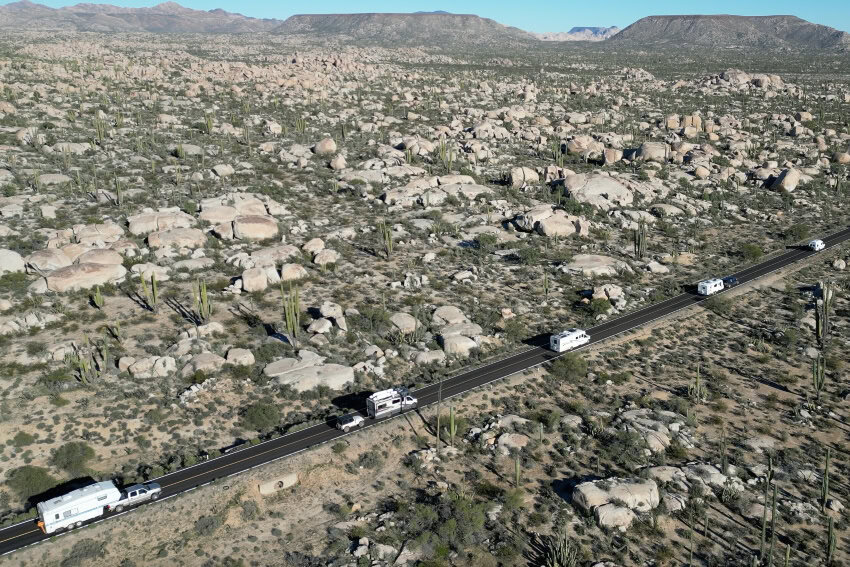
By far, the best thing about joining one of our Baja Amigos caravan tours is the small-group size. That differentiates us from other companies operating in Baja. We have a 15-person maximum, typically in seven RVs, which creates the most intimate experience possible. Guests remain close on the highway during drive days and camp together each night. Our small group size creates a perfect environment for both impromptu and scheduled happy hours and meals together, where strangers become friends and create lifelong memories together.
We also cut [out] months, if not years, of planning logistics and overcoming stressful situations. For instance, dealing with border crossings and driving on challenging roads. Most of our wagonmasters have traveled the peninsula for decades and add their own flair to the tour, where they have relationships, activities or other experiences that go above and beyond guest expectations. We constantly improve the guest experience by amending the itineraries each year based on guest feedback and the changing opportunities in Baja.
We tell our guests to let us do all the planning and worrying so they can make the most of enjoying their Baja camping adventure. And for those guests who make their decisions based just on the bottom-line costs, our caravans have always been and continue to remain the most affordable of any option. We provide an incredible amount of value for our guests, including unique experiences and meals that reflect the cultural and geographic diversity of the peninsula. Through years of leading tours, we’ve found a great balance between including not-to-be-missed activities with the freedom and flexibility for guests to experience more of the kind of things they may enjoy the most.
Of course, we’ve also built in the safety-in-numbers principle, and we only camp in reputable, established campgrounds or campsites where our guests feel secure. We also have great relationships with community members and vendors from years of operating in Baja, where our guests can know that their patronage has a positive impact in supporting great people and communities.
What are the top camping spots with amenities versus rustic sites in Baja?
For RV campers looking for formal campgrounds with amenities comparable to what they may be used to in the U.S. and Canada, regions near the border and a handful of other destinations scattered throughout the peninsula tend to offer the best camping opportunities. Clam Beach Resort near Ensenada and Pete’s Camp in San Felipe are two such options for campers looking for full hookups and the convenience of either camping on the beach or within walking distance to it.
Further south in La Paz, Campestre Maranatha offers arguably the best campground experience in Baja California Sur with level sites, full 50-amp hookup and a refreshing pool. Most other campgrounds in Baja offer a little of what one might expect north of the border, but are much more rustic. Most of the more popular destinations have campgrounds that make visiting convenient and comfortable.
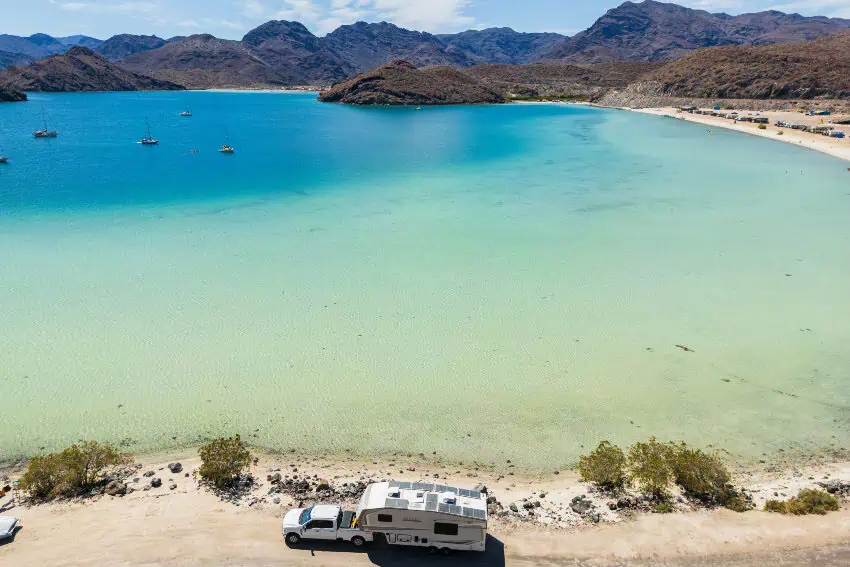
Typical electric hookups at most campgrounds are 15-20 amp, and many campgrounds may offer a primitive dump station, as opposed to full sewer hookups. Some have restaurants, laundry facilities or other extra features onsite. But, due to the landscape, most campgrounds have mostly level sites built in the dirt, as opposed to level concrete pads.
Of course, Baja is known for its primitive desert camping experience, particularly at any number of beaches that line both sides of the peninsula. For those looking to dry camp or boondock their way through a season of camping in Baja, the possibilities are limitless, and typically, one can find a nearby campground that will allow them to empty their tanks and fill up on water.
While 4×4 is a great feature for the most adventurous of campers, many of the most popular rustic beach camping areas are easily accessible with 2WD. Nearly a dozen beaches along the Bahía de Concepción, Playa Rosarito, Bahía de San Luis Gonzaga, Bahía de Los Ángeles, Playa Los Cerritos and Cabo Pulmo are among the most popular beach camping destinations for those willing to trade the convenience of modern hookups for the chance to wake up in a truly beautiful part of the peninsula.
It seems like winter is when most people want to RV through Baja. Is that when you’re planning your next Baja Amigos caravan?
Yes, by far, the best and most popular time for RVers to visit Baja is between November and early April. The late spring through early fall can be unbearably hot. However, for campers escaping the cold northern winters, Baja is a paradise between November and March. This coincides with wildlife migrations such as gray and humpback whales and whale sharks, and makes spending time on the water or camping next to it ideal.
Typically, most campers leave Baja just before the busy Semana Santa, the Holy Week before Easter, as this is a special time of celebration for most Mexican communities.
We offer all our caravans during this peak travel season, with our next Baja Amigos caravan departing the U.S. on November 7 for a 40-day fall adventure. Lindsay and I have been returning to Baja by early November each year since we discovered the beauty of the peninsula in 2019, and this is one of our favorite caravans to lead because we spend a bit more time on a few of our favorite beaches and we beat the rush that tends to fill up the peninsula after the holidays.
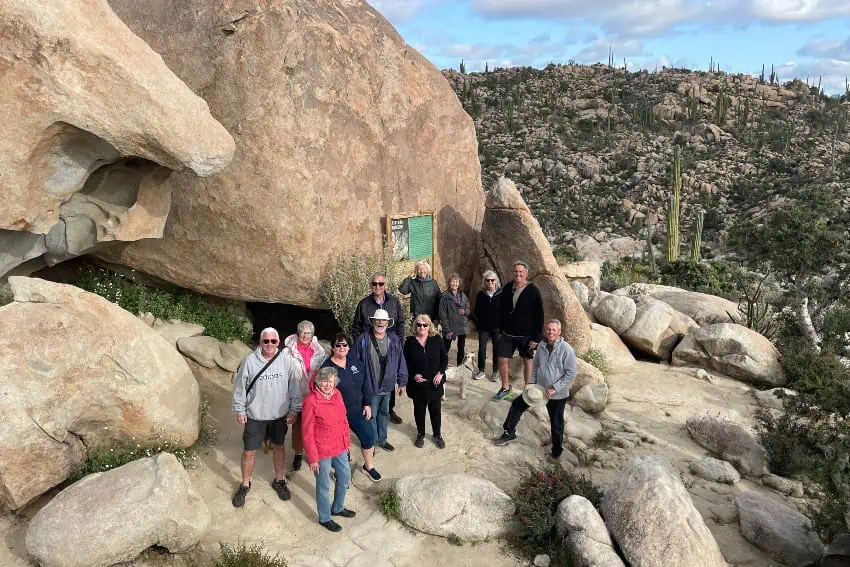
However, we also offer one of our 30-day small-group caravans in both January and March, and we have three February offerings led by our amazing wagonmaster team. We also have a shorter 18-day “beaches-and-whales” themed caravan that Lindsay and I lead at the end of January.
How did you and Lindsay first become interested in RV travel?
Lindsay and I met in Cuba in March 2013 and were married on an island off the coast of Honduras at the end of the year. Travel and adventure have been a part of our marriage from the very beginning. In 2016, we became foster parents for up to eight children at a time, working as house parents for an orphanage in Florida.
With no kids of our own, the time with the children was incredibly fulfilling and allowed us to care for kids who would otherwise not have such a loving home. But we sensed that adventure awaited once our time with the orphanage was over. Sometime in our first year as foster parents, we began studying and planning a way to drive the Pan-American Highway from Alaska to Argentina. We purchased a flatbed F-250 and a slide-in truck camper and began making preparations for the journey.
Two years later, most of the kids in our care were either reunited with their families or adopted, and we made a clean break from the orphanage to pursue our adventure to reach Deadhorse, Alaska, at the top of the world. In July 2018, we pulled into Deadhorse and swam in the Arctic Ocean. Then we turned south on our drive toward Argentina.
As we say, over the next year, everything but the wheels fell off in our plans. We returned to Florida at the end of 2018 to complete some substantial mechanical repairs and regroup before driving west to cross into Baja on our way south. We planned to take the ferry from La Paz to the mainland and continue south into Guatemala and beyond. However, early 2020 had other plans for us — and everyone else — and we realized that crossing international borders was not going to be feasible or advisable with all the uncertainty in the world.
What happened then?
We found ourselves in a holding pattern, taking the fall of 2020 off [from] visiting Baja, but realizing that as long as Mexico remained welcoming to tourism, we could always return to Baja. We spent six more months in our second winter season, further exploring and falling in love with the people, culture, landscapes and wildlife in Baja. At that point, we were hooked and abandoned any thought of the Pan-American Highway as we fell further and further in love with the peninsula.

While drawing a map in the sand for a couple we met on a beach, they suggested that we should write a book or lead others through Baja based on what we knew. It sounded far-fetched at the time. But we did just that, publishing the first edition of our guidebook in 2022. We began our own caravan company shortly thereafter.
As part of our business strategy, we reached out to the existing caravan companies to let them know that we wanted to peacefully coexist in helping first-time travelers explore and enjoy the peninsula. We received curious responses from two companies. The owners of one, Baja Amigos, responded incredibly welcoming, inviting us to not only operate our company side-by-side with theirs but also to teach us the ropes about operating caravans in Baja.
How did you come to operate Baja Amigos?
Our relationship with the owners deepened over the next two years. To the point that it made more sense for us to assume the operations of Baja Amigos rather than to start our own company from scratch. We ended up leading two caravans for them in the spring of 2024, further solidifying our relationship with the owners and realizing that our values were nearly identical: small group sizes, well-rounded and unique experiences that teach respect and support for local Mexican people and communities in which we travel.
It was natural to carry the torch forward for the owners. We share the same vision for helping our guests experience the things that made us so quickly and passionately fall in love with Baja — its people, culture, landscapes and wildlife.
We look forward to continuing to share our passion and experience with our guests as we constantly look to grow and deepen relationships with campground owners, vendors and tour operators in Baja, built on those that the owners of the company have established over the past two decades of traveling independently and as caravan leaders throughout the peninsula.
Chris Sands is the Cabo San Lucas local expert for the USA Today travel website 10 Best, writer of Fodor’s Los Cabos travel guidebook and a contributor to numerous websites and publications, including Tasting Table, Marriott Bonvoy Traveler, Forbes Travel Guide, Porthole Cruise, Cabo Living and Mexico News Daily. His specialty is travel-related content and lifestyle features focused on food, wine and golf.
